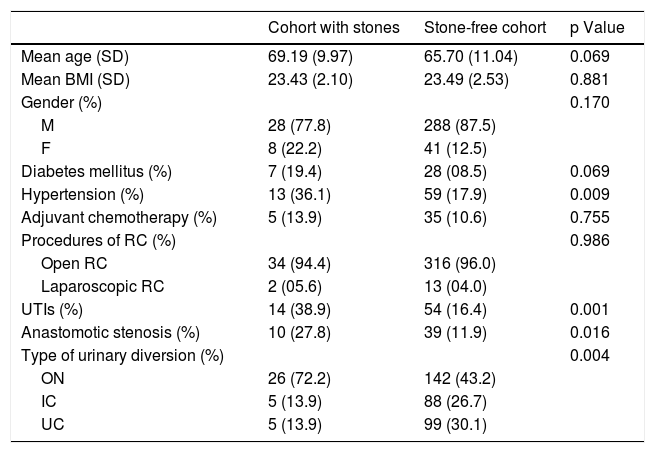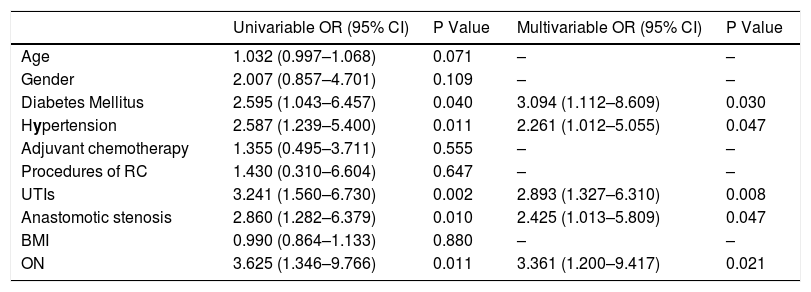The study was conducted to identify the risk factors of upper tract stone formation in patients with diversions after radical cystectomy (RC).
Materials and methodsAll patients with diversion after RC were collected in our center from January 2005 to December 2013. Three different common diversions were included: Orthotopic neobladder (ON: 168 patients), Ileal Conduit (IC: 93 patients) or Ureterocutaneostomy (UC: 104 patients). Univariable and multivariable logistic regression analysis were conducted to identify the independent predictors of stone formation in the upper tract.
ResultsA total of 365 consecutive patients (316 males, 49 females) were included. At a median follow-up of 48 months (range 12–65 months), 36 patients (9.9%) developed upper tract stone. Among them, 26 (72.2%), 5 (13.9%) and 5 (13.9%) patients underwent ON, IC and UC, respectively. 25 patients had renal stone and 11 ureter stone. Minimally invasive operations (endoscopic laser lithotripsy via the anterograde or retrograde approach in 24 cases, percutaneous nephrolithotomy in 9 cases and shock wave lithotripsy in 3 cases) were carried out successfully in all stone cases. On univariable and multivariable logistic regression analysis, diabetes mellitus, hypertension, urinary tract infection (UTI), anastomotic stenosis and types of diversions (P<0.05) were positively associated with upper tract stone formation.
ConclusionsThe variable predictors of upper tract stone may contain diabetes mellitus, hypertension, UTI, anastomotic stenosis and types of diversion.
El estudio se realizó con el objetvo de identificar los factores de riesgo de la formación de cálculos en el tracto urinario superior en pacientes con derivación urinaria tras cistectomía radical (CR).
Materiales y métodosSe recogieron los datos de todos los pacientes con derivación después de la CR tratados en nuestro centro desde enero 2005 hasta diciembre 2013. Se incluyeron tres tipos de derivaciones diferentes: neovejiga ortotópica (NO: 168 pacientes), conducto ileal (CI: 93 pacientes) o ureterostomía cutánea (UC: 104 pacientes). Se realizó análisis de regresión logística univariante y multivariante para identificar los predictores independientes de formación de cálculos en el tracto superior.
ResultadosSe incluyeron 365 pacientes tratados consecutivamente (316 hombres, 49 mujeres). Con una mediana de seguimiento de 48 meses (rango 12–65 meses), 36 pacientes (9,9%) desarrollaron cálculos en el tracto superior. Entre ellos, 26 (72.2%), 5 (13.9%) y 5 (13.9%) pacientes fueron sometidos a NO, CI y UC, respectivamente. 25 pacientes presentaron cálculos renales y 11, cálculos ureterales. La cirugía mínimamente invasiva (litotricia endoscópica con láser mediante abordaje anterógrado o retrógrado en 24 casos, nefrolitotomía percutánea en 9 casos y litotricia con ondas de choque en 3 casos) se realizó con éxito en todos los casos. En el análisis uni y multivariante de regresión logística, se encontró que las variables diabetes mellitus, hipertensión, infección del tracto urinario (ITU), estenosis de la anastomosis y el tipo de derivación se asocian positivamente con la formación de cálculos en el tracto urinario superior.
ConclusionesPodemos afirmar que la diabetes mellitus, hipertensión, ITU, estenosis de la anastomosis y el tipo de derivación son variables predictoras de la formación de cálculos en el tracto superior.








